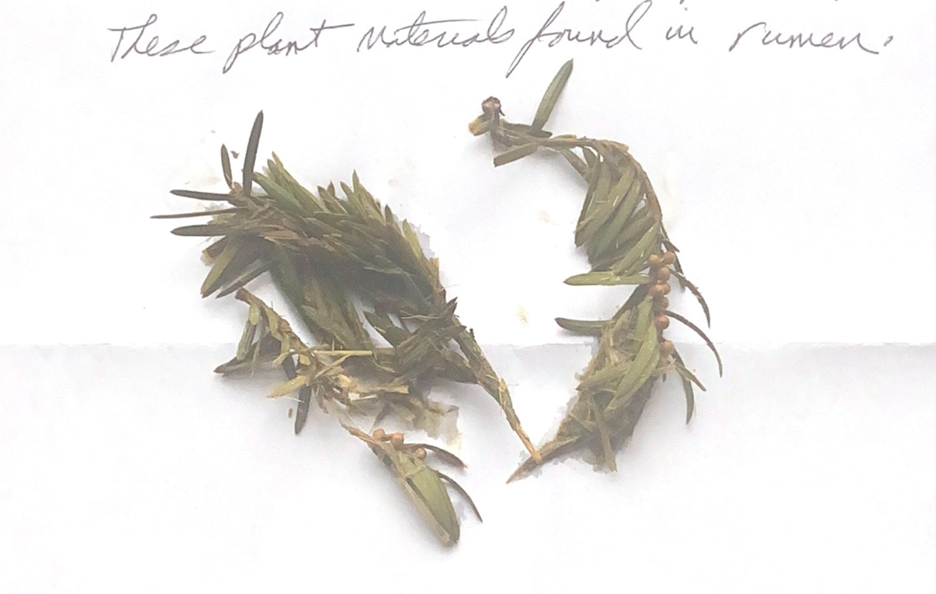Taxus spp Toxicosis
Accidental ingestion of Japanese yew (Taxus cuspidata) led to the sudden death of four New England beef cattle in late January 2024. These four cows were noted to be apparently healthy until being found dead over a 3-day period, and there was a herd history of pasture escape. The producer described the first cow to have been seen eating and behaving normally, then moments later collapsed and died. The three other cows were found dead in the pasture. No abnormal gross lesions were noted during field necropsies. Pieces of pine tree branches and berries were found in the rumen contents of two cows (Figure 1), a photo of which was shared by the herd veterinarian with Veterinary Support Services at the Animal Health Diagnostic Center (AHDC). Dr Karyn Bischoff, director of the AHDC Toxicology Laboratory, identified these branches as Japanese yew. Upon investigation of the area surrounding the pasture, several Japanese yew bushes were identified with signs of grazing and were presumed to be the cause of toxicosis and sudden deaths in the herd.

Figure 1: Japanese yew found in rumen contents
Taxus spp., or Japanese yew, are evergreen plants that are commonly used for decorative landscaping throughout the United States and the world. They contain taxine alkaloids that primarily cause toxicity through antagonism of calcium channels in cardiac myocytes, resulting in electrical conduction disturbances in the heart muscle, often resulting in acute death. Clinical signs vary depending on the amount of toxin ingested, and include ataxia, bradycardia, dyspnea, muscle tremors, and seizures leading to collapse and death. In most cases, animals are found dead within twenty-four hours of ingestion without showing any premonitory clinical signs. Domestic livestock, including cattle, horses, and small ruminants, are among the species susceptible to Taxus spp toxicosis1. While postmortem cardiac lesions have been sporadically reported, there are no common pathognomonic lesions of Taxus spp toxicosis in livestock.2,3 Diagnosis of Taxus spp toxicosis is often made based on history of exposure and unexpected death, followed by identification of the plant in the digestive tract. Many case reports describe accidental exposure to Taxus spp through ingestion of clippings inadvertently discarded in the pasture resulting in high herd mortality.1-3 Taxus spp. toxicosis may occur more frequently during winter months, when concentrations of alkaloids are highest, and the evergreen leaves become more appealing.2 This case exemplifies how the submission of stomach/rumen/abomasal contents for gross or microscopic evaluation by a board-certified veterinary toxicologist can assist in making a diagnosis of toxicosis.
References
- Wilson, Christina R., and Stephen B. Hooser. Veterinary Toxicology: Basic and Clinical Principles, edited by Ramesh C. Gupta, Elsevier/Academic Press, London, 2018, pp. 929–935.
- Sula MJM, Morgan S, Bailey KL, Schumpert M, Njaa BL. Characterization of cardiac lesions in calves after ingestion of Japanese yew (Taxus cuspidata). Journal of Veterinary Diagnostic Investigation. 2013;25(4):522-526. doi:10.1177/1040638713489981
- Burcham GN, Becker KJ, Tahara JM, Wilson CR, Hooser SB. Myocardial fibrosis associated with previous ingestion of yew (Taxus sp.) in a Holstein heifer: evidence for chronic yew toxicity in cattle. Journal of Veterinary Diagnostic Investigation. 2013;25(1):147-152. doi:10.1177/1040638712466729


